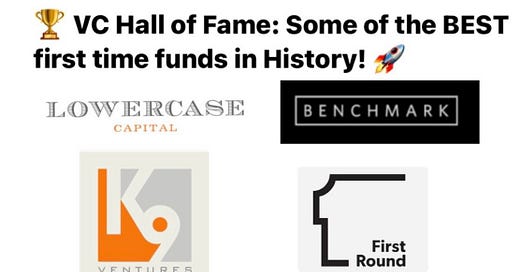👋 Hi, I’m Doug! Welcome to @TheFundCFO crew! Every Tuesday/[Thursday], we publish VC/CFO insights that matter - highlights from notable VC GPs, LPs, and CFOs/finance pros. Check out our VC Fund Playbooks, Models, Budgets, & Compliance Checklists @ AirstreamAlpha Products!
Need more help? Check out Fund CFO Support provided by the Airstream Alpha Team.
Love what we’re doing? Consider upgrading to paid for deeper dives on Thursdays (most paid subscribers expense these insights!).
Top Recent Posts - Check Them Out!
#219 Size Matters in VC (Cont'd) & DPI / Premium Carry Templates
#218 Size Matters: Small vs. Big VC (5x+ vs. 2x+), Lightspeed Returns Detail
LA VC Week Recap: Upfront in Los Angeles
As we shared earlier this week, the VC world (along with LPs, founders) descended upon Los Angeles this week. The daily Fortune Term Sheet email (linked above) did a great job recapping the event. Some highlights:
In 2024, the conference was held in a West Hollywood movie studio lot, and everyone was still bundled up for VC winter. In 2025, I’m writing this from the Intuit Dome’s courtyard, encircled by food trucks, bright umbrellas, and hundreds of VCs, LPs, and conference-goers. I hesitate to call VC spring, but there’s definitely a sense of optimism—even if it’s complicated. Sequoia partner Pat Grady told the audience that, when it comes to VC as a whole, he’s a “short-term pessimist, long-term optimist.”
“If I unpack that a little, why am I a short-term pessimist? Well, if you go back to the origins of venture capital, it’s been a cottage industry for most of its existence,” said Grady. “But thanks to the last ten or 15 years, ZIRP, coupled with the cloud and mobile super cycle, it’s gone from being a cottage industry to being a business…When you’re in business, the business of business is business. Now, you’re focusing on maximizing shareholder value. That takes you down a different path.”
Is VC back?! We lean towards the indicators for optimism in 2025 - we’ll see!
Top Performing DPI Funds (They’re All Small :))
In our Size Matters: Small vs. Big VC Funds post we shared that smaller funds often achieve higher multiples.
“Some of the 𝗕𝗘𝗦𝗧 performing 𝗳𝗶𝗿𝘀𝘁-𝘁𝗶𝗺𝗲 VC funds in history are small & have returned astonishing multiples of capital.”
To back this up, our friend Akhil Paul posted in his LinkedIn a list of some of the BEST small VC funds returning their LPs between 𝟮𝟬 to 𝟮𝟱𝟬𝘅 of capital!
Benchmark I // Fund Size: ~$85mn (1995)
Return: 𝟵𝟮𝘅
Founders: Bruce Dunlevie, Andy Rachleff, Bob Kagle, Kevin Harvey
Investments incl. eBay (*The $6.7Mn investment became $7Bn in 2 years! One of the best investments in history).First Round Capital I // Fund Size: ~$6mn (2005)
Return: ~ 𝟰𝟬𝘅
Founders: Josh Kopelman & Howard Morgan
Investments incl. Roblox, UberK9 Ventures I // Fund size: $6mn (2009)
Return: ~ 𝟭𝟬𝟬𝘅
Founder: Manu Kumar
Investments incl. Twilio, Lyft & Carta (where he was co-founder)Founder Collective I // Fund size: $50Mn (2009)
Return: ~ 𝟮𝟱𝘅
Founder: Eric Paley & David Frankel
Investments incl. Uber, Pillpack, CoupangLowercase Capital I // Fund Size: $8.5mn (2010)
Return: ~ 𝟮𝟱𝟬𝘅
Founder: Chris Sacca
Investments incl. Uber, Instagram & Twitter
What LPs Look For: A Checklist (James Heath)
Investing in a VC fund is a high-stakes decision for LPs. To separate promising funds from those that are unlikely to perform, LPs conduct deep diligence in five key areas:
1. Track Record
VC is an outlier asset class—look for GPs who can consistently find the needle in the haystack. IRR, TVPI, and DPI are assessed together, not in isolation. Here, it’s all about a GP’s understanding of and ability to execute against the power law.
2. Thesis
A large portfolio may be more likely to return capital to investors, but multiples of the fund become more challenging without material ownership. The more material the LP, the more likely the investor is going to assess their ownership in the underlying portfolio companies.
3. Co-Investments
Not every VC can offer co-investments—some sectors, like life sciences, bring inherent challenges.
When GPs bring co-investment opportunities, it’s good practice to see underwriting and an understanding of the quantitative assessment of the business. By Series B+, the assessment has changed from qualitative to quantitative, and an objective view is necessary.
4. People
VC is the most people-driven asset class; back GPs that founders are genuinely excited to work with. The best emerging managers share key traits:
A deep, differentiated network
Great pickers
A structured approach
This is the area that has evolved for me the most. Early-stage venture is a qualitative game—people over numbers. Founders don’t care about the firm’s brand; they care about the individual person investing in them. Assessing the team is where I spend most of my investment decision-making time.
5. Terms
The GP/LP relationship lasts longer than the average marriage—so terms matter. The 2/20 model is the world's second most lucrative business model after Google’s, so don’t fix what isn’t broken. If a GP wants higher fees or ratchets, a ceiling needs to be surpassed. The overwhelming majority don’t reach this ceiling. High-profile funds such as USV have stuck to the 2/20 model, and so should everyone.
Link to Top Premium Content (Premium Subscribers)
Here’s a link to some of our top premium content related to DPI. If you want to dive deeper into fund modeling, DPI strategies, and other premium content tailored to venture capital and finance professionals, feel free to message me!
Keep reading with a 7-day free trial
Subscribe to @TheFundCFO Newsletter to keep reading this post and get 7 days of free access to the full post archives.




